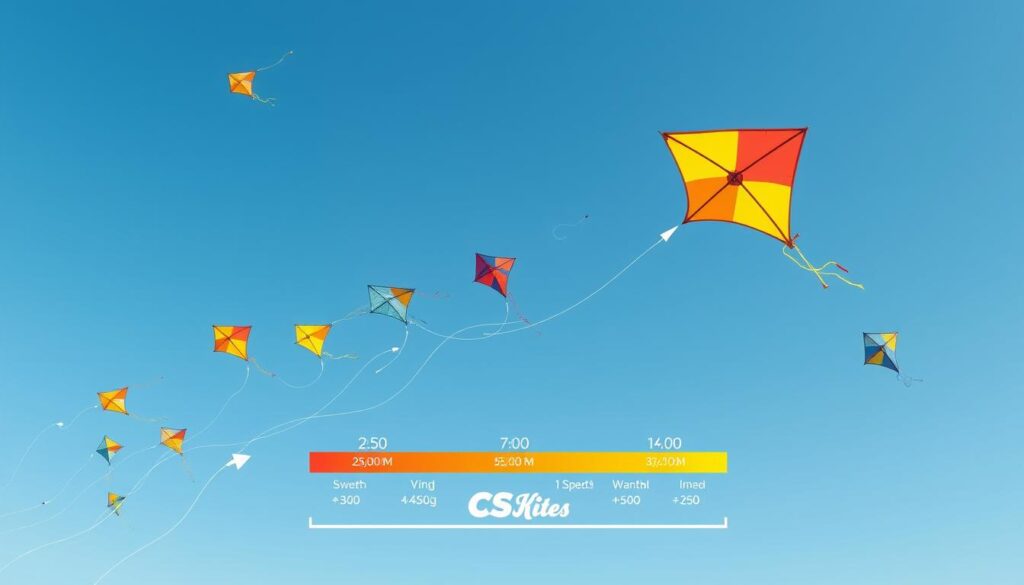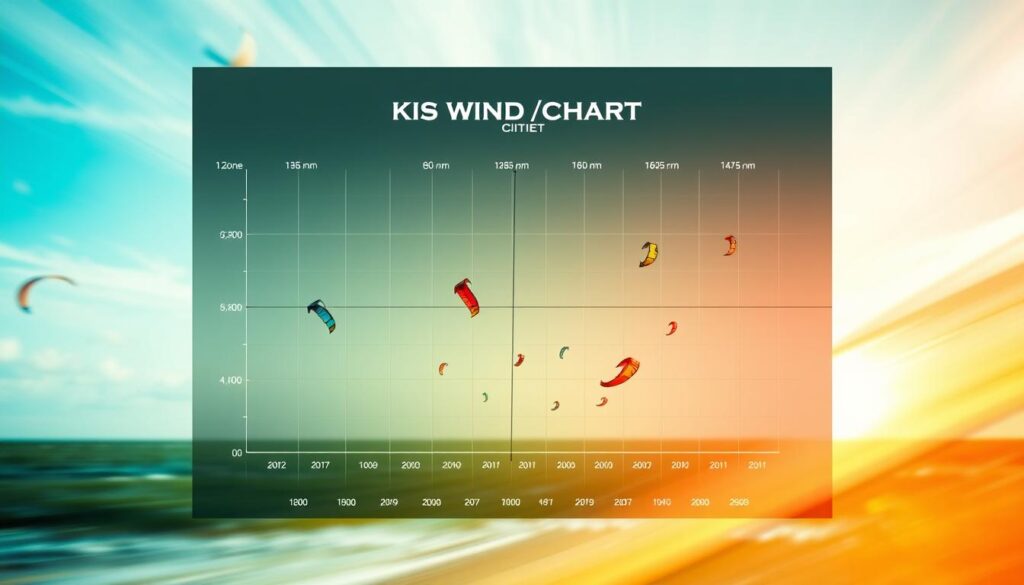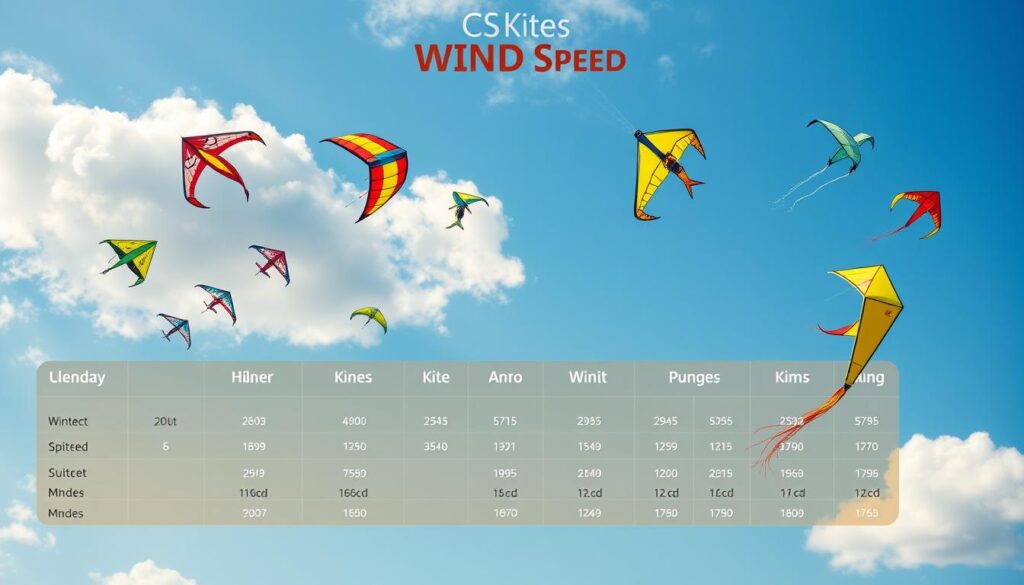Ever wonder how kite flyers seem to dance with the wind? They effortlessly soar their colourful creations across the sky. The secret is knowing the wind speed and kite performance relationship. As a kite enthusiast, I’ve found that mastering the kite wind speed chart is key for a safe and fun flying experience.
Wind conditions are crucial for kite flying at the beach or park. Too little breeze, and your kite won’t fly. Too much, and it could be dangerous. That’s why a wind velocity guide for kites is important. It’s not just about feeling the wind; it’s about knowing the numbers for your kite.
I’ve spent hours studying kite wind speed charts and testing different kites. I’ve learned how these charts help pick the right kite for the day. They ensure a safe flight. Whether you’re new or experienced, knowing these charts is vital for enjoying kite flying.
Key Takeaways
- Kite wind speed charts are essential tools for safe and enjoyable flying
- Wind conditions greatly impact kite performance and safety
- Different kites are designed for specific wind speed ranges
- Understanding wind velocity guides helps in selecting the right kite
- Proper use of wind speed charts can enhance your kite flying experience
What is a Kite Wind Speed Chart?
As a kite flyer, knowing wind speeds is key for a good time. A kite wind speed chart helps me pick the right kite for the wind. It also shows what my kite can handle.
Definition and Purpose
A kite wind speed chart shows the wind range for different kites. It lists the wind speeds for safe and best kite flying. This chart is key for choosing the right kite for the wind.
Importance for Kite Flyers
For kite lovers, these charts are a must. They keep us safe by telling us when it’s too windy. By picking the right kite for the wind, we fly better and keep our gear safe.
| Wind Speed (knots) | Kite Size (m²) | Rider Weight (kg) |
|---|---|---|
| 3-6 | 9 | 43-75 |
| 6-10 | 7 | 75-100 |
| 10-15 | 5 | 100-118 |
I’ve learned that weight and skill matter too. Beginners need bigger kites for stability. More experienced flyers might choose smaller kites for better control. Knowing this helps me pick the best kite for the wind.
How to Read a Kite Wind Speed Chart
Understanding a wind velocity guide for kites is key for safe and fun flying. A kite wind window chart helps me pick the right kite for the weather.
Understanding Wind Speed Measurements
Wind speed is measured in knots (kts). 1 knot is about 1.852 km/h or 0.5144 m/s. Kitesurfing starts at 8-16 knots, but experts can go as low as 5-6 knots with special gear.
For newbies, the best wind is 14-21 knots. More experienced kite surfers might go up to 27 knots, but safety always comes first.
Interpreting Chart Icons and Symbols
Kite wind window charts use icons and colours for the best flying times. Wind direction is shown with arrows. For instance, an arrow pointing right means the wind is coming from west to east.
| Wind Speed (knots) | Kite Size | Skill Level |
|---|---|---|
| 5-10 | Large | Advanced |
| 11-15 | Medium | Intermediate |
| 16-20 | Small | Beginner |
I also look for symbols for wave height and rain. Waves over 1.5 meters are tough, and rain makes it hard to see. Learning about these helps me fly my kite better.
Optimal Wind Speeds for Different Kites
Knowing the optimal wind speed for kites is key for safe and fun flying. I’ve learned that different kite types and sizes do best in certain winds. This helps me pick the right kite for the weather.
Best Conditions for CS Kites
CS Kites has many options for various wind speeds. Their kites are reliable in different conditions. Beginners should start with a bigger kite in winds between 14-21 knots.
Kites Suitable for Various Wind Conditions
The safe windrange for kite flying changes with kite type and size. Here’s a quick guide I follow:
- Light winds (8-14 knots): Larger kites (12-14m)
- Moderate winds (15-20 knots): Medium kites (9-11m)
- Strong winds (21+ knots): Smaller kites (5-8m)
I also think about my weight when picking a kite size. Here’s a chart I use:
| Rider Weight (kg) | Rider Weight (lb) | Kiteboard Size (cm) | Kiteboard Width (cm) |
|---|---|---|---|
| 56-68 | 125-150 | 134-148 | 41 |
| 68-81 | 150-180 | 140-160 | 43 |
| 81-95 | 180-210 | 142-165 | 45 |
| 95+ | 210+ | 146-165 | 46 |
Keep in mind, these are just guidelines. Wind can change fast, so I always stay alert and adjust my kite choice as needed.
Factors Affecting Wind Speed
Understanding wind conditions is key for a great kite flying experience. I always check the wind speed and direction before flying. This helps me stay safe and have fun.
Local Environment Influence
The area around me affects the wind. Near buildings or trees, the wind can be tricky. But open fields usually have steady winds, perfect for my kites.
Weather Patterns and Changes
Weather changes can impact kite flying. I watch for fronts or pressure systems that can change the wind. Coastal areas often have steady sea breezes, great for kite flying in the afternoon.
To pick the right kite, I use this chart:
| Wind Speed | Kite Size | Suitable for |
|---|---|---|
| 8-15 knots | 15-12m² | Beginners, light wind days |
| 15-25 knots | 12-9m² | Intermediate flyers, most conditions |
| 25-40 knots | 9-6m² | Experienced flyers, strong winds |
| 40+ knots | 6m² and lower | Experts only, extreme conditions |
By thinking about these factors and using wind charts, I make sure my kite flying is fun and safe. I adapt to different wind conditions.
Why I Trust CS Kites
I’ve found my go-to source for quality kites that stand up to various wind conditions. CS Kites, based in Hong Kong, has won me over with their impressive selection and commitment to traditional craftsmanship.
Quality and Variety of Kites
CS Kites offers an extensive catalogue with over 100 kite choices. This variety ensures I can find the perfect kite for any wind speed or flying condition. Their focus on durability means I can rely on my kites to withstand the elements, session after session.
When consulting my kite wind speed chart, I’m confident that CS Kites has options suitable for every range. Whether I’m facing light breezes or strong gusts, there’s a kite in their collection that’s up to the task.
Supporting Traditional Crafts
By choosing CS Kites, I’m not just getting top-notch flying gear. I’m also supporting skilled artisans who keep traditional kitemaking alive. This connection to heritage adds depth to my kite flying experience.
For kite enthusiasts like me, having access to wind guidelines is crucial. CS Kites provides detailed information about each kite’s optimal wind range, helping me make informed choices. This commitment to education aligns perfectly with my passion for safe and enjoyable kite flying.
How I Choose the Right Kite
Finding the perfect kite is key for a great flying time. Knowing the kite flying wind range and windspeed needs is vital. I pick kites based on my skill level and expert advice.
Assessing My Experience Level
I first check my skill level. As a beginner, I chose bigger, steadier kites. Now, with more skill, I can fly different sizes. I pick kites that match the wind I’ll face.

Consulting with Benny for Recommendations
Benny, an expert at CS Kites, gives me great advice. He considers my weight, wind speeds, and flying style. His tips on windspeed are super helpful.
Our talks taught me that riders around my size start with a 12m kite. It’s smart to have two kites for different winds. This has made flying kites much better for me.
“Understanding your skill level and local wind patterns is key to choosing the right kite. It’s not just about the size, but how it fits your flying style,” Benny often reminds me.
By using my own judgment and Benny’s advice, I’ve got kites for all winds. This has really boosted my kite flying skills and fun.
Family Kite Flying: A Joyful Experience
Kite flying is a great way to bond with family and make memories that last. Knowing the wind conditions is crucial for a good time. With the right guide, even newbies can have a blast.
Sharing the Excitement with Children
I love teaching kids about kite flying. It’s fun and educational. They learn about aerodynamics and weather while staying active.
The best wind speed for flying kites is between 8 to 20 mph. I always check this before we go.
- Promotes physical activity and coordination
- Enhances problem-solving skills
- Boosts emotional well-being
- Encourages creativity in kite design
- Fosters social connections
Creating Lasting Memories
The best places for kite flying are coastal areas, large parks, and lakeshores. These spots have steady winds, making it easy to fly kites. Clear skies are best, but cloudy days work too.
Safety is key when flying kites with family. I check for power lines and avoid crowded areas. It’s also important to protect against the sun and teach how to handle strings safely.
| Location | Ideal Wind Speed (mph) | Best Time of Day |
|---|---|---|
| Coastal Areas | 5-20 | Mid-morning to early afternoon |
| Large Parks | 8-20 | Late morning to mid-afternoon |
| Hilltops | 5-25 | Early morning or late afternoon |
By picking the right spot and following these tips, our kite flying trips are always safe, fun, and memorable.
Enhancing My Skills Through Community
Joining kite flying societies has really helped me improve. I’ve learned a lot about kite wind window charts and wind guidelines. These groups are full of useful information.
Joining Kite Flying Societies
Being part of these societies has given me access to great resources. They offer workshops on reading wind maps. This has made me better at understanding wind speeds and directions.

Learning from Others' Experiences
Sharing wisdom is the best part of kite flying communities. Experienced flyers have taught me a lot. They’ve shown me how to use kite wind window charts and find the best wind conditions.
For beginners, the best wind range is 8-30 knots. More experienced flyers can handle winds up to 40 knots. This knowledge helps me decide when and where to fly my kites.
Community events have also introduced me to different kites. I’ve learned about twintip kiteboard sizes for various wind conditions. For example, a 140 x 42cm board is perfect for a 50-80kg beginner like me.
Through these societies, I’ve also learned about wind directions. I’ve found that cross-onshore winds, blowing at about a 45-degree angle to the shore, are safest. This knowledge has made my kite flying safer and more fun.
Conclusion: Embracing the Joy of Kite Flying
Reflecting on my kite flying journey, I see how crucial kite wind speed charts are. They’ve been essential for my growth in this hobby. They help me pick the right kite for each situation, making sure I’m safe and having fun.
The Importance of Safety and Fun
Safety is key in kite flying. I always check the wind speed before flying. This, along with the right gear and skills, makes my flights exciting and safe. It’s about avoiding risks and enjoying every moment.
My Continuous Journey with Kites
My kite flying journey is ongoing. I’m always ready to learn about wind and kite types. CS Kites has been a great help, offering top-notch products and advice for all winds. I’m excited for more days of peaceful flying and stunning views.
FAQ
What is a kite wind speed chart?
A kite wind speed chart helps me pick the right kite for flying. It shows the wind speeds that are best for different kites. This chart has lower and upper limits for safe flying.
How do I read a kite wind speed chart?
To read a kite wind speed chart, I need to know about wind speed. It’s measured in knots, mph, or km/h. The chart uses icons or colours to show when it’s best to fly.
What are the optimal wind speeds for different kites?
Wind speeds for kites vary by size and type. For example, a 17 sqm kite is best in 8-10.8 knots. A 5 sqm kite works in 24.8-28.4 knots. CS Kites has many kites for different winds.
What factors affect wind speed for kite flying?
Many things can change wind speed for kite flying. Local areas, weather, and even trees can affect it. Knowing these can help me pick the right kite.
Why should I trust CS Kites for my kite flying needs?
CS Kites is trusted for their quality kites. They have over 100 kites that are durable and fly well. They focus on traditional craftsmanship and offer expert advice.
How do I choose the right kite for current wind conditions?
I choose a kite based on wind and my skill level. Talking to Benny from CS Kites helps me make the best choice. This way, I can fly safely and improve my skills.
Is kite flying a good family activity?
Yes, kite flying is great for families. It’s safe and fun for everyone. It’s a way to make memories and enjoy the outdoors together.
How can I enhance my kite flying skills?
Joining kite flying groups helps a lot. I learn from others and get tips. It’s a fun way to improve and learn more about kite flying.
What’s the importance of understanding kite wind speed charts?
Knowing about wind speed charts is key for safe flying. It helps me pick the right kite and fly well. It’s also important for safety and enjoyment.
What are some wind guidelines for kite enthusiasts?
As a kite enthusiast, I follow some rules. Always check the wind before flying. Use a wind meter or look at flags. Choose a kite that fits the wind speed. And always follow the kite wind limits to fly safely.

